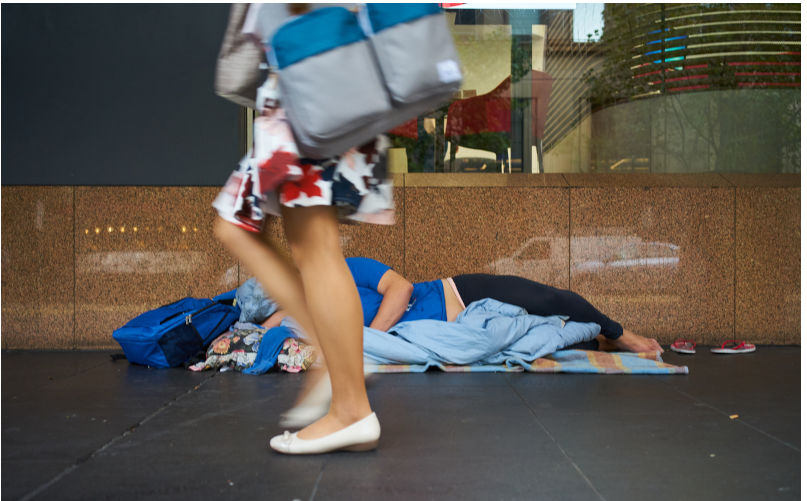Governments are not grasping the urgency to provide immediate relief in temporary accommodation for those caught up in homelessness. Political discourse is almost solely focused on providing affordable and social housing. But making good on these promises will take years.
While we wait, we need an additional emergency investment in refitting existing vacant buildings as homeless shelters. This collective response would prevent or relocate people living in flimsy tents and cramped cars. It would assist councils, police, ambulance services, homelessness service providers and charities to navigate the homelessness crisis. In properly managed shelters, individuals and families sleep safely in individual rooms or in partitioned units and share the same facilities.
Where this stopgap measure has been proposed, however, it has been vigorously resisted. This is exemplified in frustrated efforts to provide a homeless shelter in the regional city of Bunbury.
For seven years, stakeholders have been asserting the need for this service for diverse groups of vulnerable citizens.
In 2017, crisis and transitional accommodation was sought for methamphetamine-addicted individuals seeking rehabilitation. During the COVID pandemic, safety in shelter was needed for homeless people. In 2020, a consultation was undertaken to address homelessness in a vacant government facility, but the plan was shelved. In 2022, shelter for released inmates was requested – the $24 million expansion to the local prison failed to supply sufficient post-release accommodation!
By 2023, calls for a homeless shelter began including evidence of increasing rates of homeless working people who could not afford soaring rents.
By the end of that year, politically active members of the local Labor branch, tasked with identifying problems and suggesting solutions, introduced a motion for a temporary emergency shelter.
The meeting was stacked with the local member’s supporters. Efforts to have a robust discussion were foiled by sensationalist claims. The motion failed. Soon after, the minister for housing and homelessness visited the city and confirmed the status quo of providing affordable and social housing.
Proponents, however, were not deterred. For them, this was a matter of natural justice. They approached local government. A motion that council advocate for a homeless shelter was unanimously supported. This delayed meetings between the mayor and minister, and the minister strategically used a reply of correspondence to deny the request.
The power that sought to crush served to fuel deliberation. Proponents produced a weekly e-letter to inform an eventual 100 self-selected participants about housing and homelessness issues.
Six months later, spurred on by high rates of homelessness, the deliberative initiative morphed into overt activism. A small and determined team re-imagined themselves as vigil keepers for homeless people and a shelter solution. They meet weekly outside the local member’s office.
In January 2025, during electioneering, the local member and minister again poured scorn on the shelter idea. Their main criticism was that a homeless shelter represents a “worse scenario”, which tacitly implies that people living rough in unsafe conditions is somehow preferable.
The team reacted and used its increased capacity to organise and connect with others in order to influence what was said publicly about homelessness. A Facebook page was launched as were paper and digital versions of a petition for a shelter. Personal connections were called upon and networks of persuasion were pursued.
The state government has now returned to power, fortified by a surplus budget and the neoliberal message of keeping the economy strong. It also continues to spruik the message that building houses is the solution.
The council, with no avenue of recourse, is soon to start issuing infringements to those sleeping in their cars in areas where tourists park. This will mean that people who have nowhere to sleep but their cars will be fined for being homeless.
Bunbury is just one example of many cities and towns around Australia which are struggling to respond to burgeoning homelessness. The refurbishment of vacant buildings as homeless shelters is a practical solution to collectively alleviating the demand for accommodation.
But the Bunbury experience also reveals another problem. Politicians are appearing less as representatives, and more as one of “them”, part of the governing apparatus. As the distance grows between the apparatus and citizens, so the latter are becoming emboldened to speak and act on behalf of their communities –work that is conventionally assigned to government representatives. Spurred on by anger at governmental intransigence, they use activism, engagement and mobilisation to strengthen their social message.
Citizens’ efforts to address the human cost of political inaction will continue. They will use multiple voices to remind governments of their obligation and duty to provide roofs over the heads of displaced citizens. They will bring attention to the weight of community support for homeless shelters by the evidence of growing numbers of people/families in this situation, and that this needs to be addressed sooner than later.
Jane Anderson is a social anthropologist and honorary research fellow, University of Western Australia. Between 1999 and 2016 Jane focused her studies on reform issues in the Catholic Church. Her PhD on priests in sexually intimate relationships was published as Priests in Love. Jane’s work Innovative Catholicism challenged her to take a different direction in life. She has since worked restoratively alongside prisoners, problematic drug users and their families, and chronic homeless people. Today, her writings are informed by restorative justice principles and a progressive Catholic Christian morality

